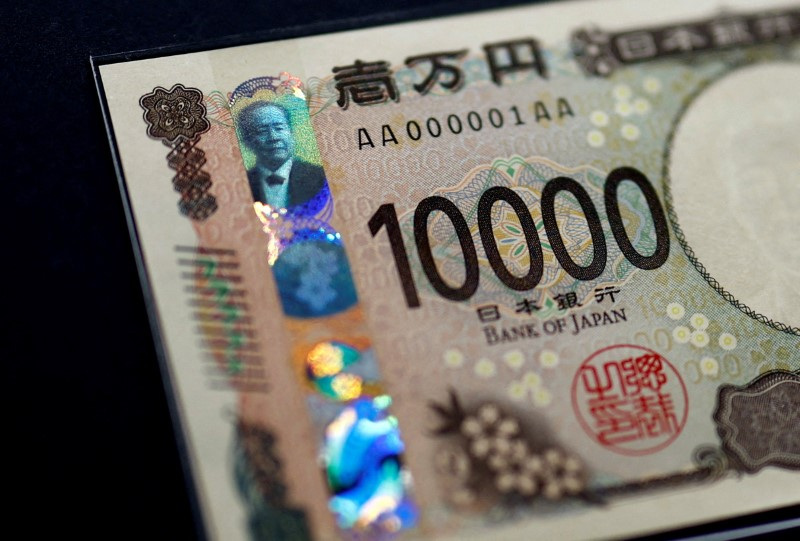By Leika Kihara, Pasit Kongkunakornkul, Vineet Sachdev and Kripa Jayaram
(Reuters) - The Japanese yen has been under pressure in the past few years as markets focused on the wide U.S.-Japan interest rate differentials.
The yen lost more than 20% against the dollar since the outset of 2022, prompting several rounds of intervention by Tokyo to prop up the currency in September and October that year. It kept falling despite further intervention in April and May 2024, touching a 38-year low of 161.96 to the dollar on July 3. Japan is suspected to have stepped in again in mid-July to put a floor under the yen.
The yen's downtrend has reversed in recent days, following the Bank of Japan's July 31 decision to raise interest rates and ahead of an expected loosening of U.S. monetary policy.
The BOJ's hawkish move, along with investors' concerns about U.S. growth, jolted global stock and bond markets. It triggered an unwinding of the carry trade, whereby investors borrow cheaply in yen to invest in higher-yielding assets. The yen rebounded sharply against the dollar, but remains relatively weak by the standards of the past few decades.
The yen's fluctuations matter because the currency has long provided a cheap source of funding for global investors, even as other central banks raised borrowing costs.
BOJ'S SHIFTING INTERVENTION GOAL
Japanese authorities had historically intervened to prevent the yen from strengthening too much, as a strong yen hurts the export-reliant economy. This trend changed in 2022, when Tokyo stepped in and bought yen to defend its value, after the currency plunged on expectations that the BOJ would keep interest rates ultra-low even as other central banks tightened monetary policy to combat soaring inflation.
In both cases, authorities buy or sell yen, usually against the dollar. The Ministry of Finance decides when to step in and the Bank of Japan acts as its agent.
The decision is highly political because Japan's reliance on exports makes the public more sensitive to yen moves than in other countries. With many manufacturers now shifting production overseas, the benefit of a weak yen has diminished. Instead, a weak yen has become a pain for households and retailers by inflating the cost of importing fuel and raw material.
Tokyo intervened on April 29 and May 1 this year, according to Ministry of Finance data, to combat the yen's declines. After the moves failed to reverse the yen's downtrend, Japanese authorities are suspected by market participants to have intervened again on several occasions in July.
Japanese authorities typically do not confirm whether they intervened in the currency market, and say only that they would take appropriate action as needed against excessively volatile foreign exchange moves.
WHY DID THE YEN WEAKEN IN RECENT YEARS?
Various factors caused the yen's decline.
First, the U.S. Federal Reserve's aggressive interest rate rises and the BOJ's slow pace in normalizing monetary policy kept the gap between U.S. and Japanese interest rates large, thereby keeping the yen less attractive compared with the dollar.
Second, Japan is now importing more fuel and raw material than in the past, which means companies are converting yen into foreign currencies to make payments.
Third, many big Japanese manufacturers that shifted production overseas have reinvested profits abroad, rather than repatriating them. That reduced demand for yen.
WHY ISN'T THE BOJ RAISING RATES MORE RAPIDLY?
The BOJ ended negative interest rates in March and raised its short-term policy rate again to 0.25% from 0-0.1% in July. Governor Kazuo Ueda has signaled the chance of raising rates again if Japan makes further progress toward meeting the central bank's 2% inflation target, as it projects.
Analysts expect the BOJ to eventually raise interest rates to levels deemed neutral to the economy, around 1% to 1.5% in the next few years. But such a gradual tightening would leave Japanese borrowing costs very low compared with other countries.
Japanese policymakers are cautious about raising rates too aggressively for fear of hurting already-weak consumption and threatening a fragile economic recovery. They are also wary of the risk of triggering a sharp rise in long-term interest rates that would increase the cost of funding Japan's huge public debt.
WHAT ARE THE DRAWBACKS OF A WEAK YEN?
A weak yen pushes up the cost of importing fuel, food and raw material. That in turn hurts retailers and households through higher living costs.
Inflation data shows that the rate of core inflation, which excludes volatile fresh-food prices but includes fuel costs, has been higher than the central bank target for the past 27 months.
WHAT ARE THE BENEFITS OF A WEAK YEN?
A weak yen, however, is not necessarily all bad for Japan's economy.
The yen's decline benefited Japanese export firms by inflating the yen-based profits they earned overseas. The increased profits may lead to higher wages and help underpin consumption.

A cheaper yen also boosts tourism. The number of overseas visitors to Japan has surged over the past couple of years, giving hotels, department stores and others relief after enduring COVID-19 restrictions.
($1 = 146.3100 yen)